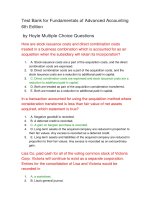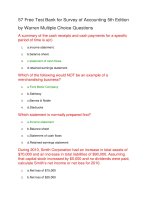Advanced accounting, 5th edition international student version ch15
Bạn đang xem bản rút gọn của tài liệu. Xem và tải ngay bản đầy đủ của tài liệu tại đây (368.51 KB, 58 trang )
15
15
Partnerships:
Formation, Operation
and Ownership Changes
Advanced Accounting, Fifth Edition
Slide
15-1
Learning
Learning Objectives
Objectives
1.
Describe the characteristics of a general partnership, a
limited partnership, and a joint venture.
2.
List some important items to be included in the
partnership agreement.
3.
Understand the differences between partnerships’ and
corporations’ equity accounts in the balance sheet.
4.
Explain the purpose of the partners’ drawing accounts
and capital accounts.
5.
Prepare journal entries to form a partnership using the
bonus and the goodwill methods.
Slide
15-2
Learning
Learning Objectives
Objectives
6.
Describe some common agreements used to allocate
partnership net income or loss.
7.
Explain why salary allowances and interest allowances
are used in allocating partnership profits and losses.
8.
Describe the methods used to record partnership
changes when a new partner is admitted or when a
partner withdraws from the partnership.
9.
Describe the rationale behind the goodwill method in
accounting for changes in partnership membership.
Slide
15-3
Partnership
Partnership Defined
Defined
“An association of two or more persons to carry
on as co-owners a business for profit.”*
Attributes:
1. Agreement, expressed or implied.
2. Operated for making a profit.
3. Members must be co-owners.
*Uniform Partnership Act (UPA), Section 6
Slide
15-4
Reasons
Reasons for
for Forming
Forming aa Partnership
Partnership
Advantages of a partnership:
Permits pooling of resources without
complexities of a corporation.
Easier and less costly to establish.
Not subject to as much governmental regulation
as a corporation.
Partners able to operate with more flexibility.
Income not subject to taxation at partnership
level.
Slide
15-5
Characteristics
Characteristics of
of aa Partnership
Partnership
General Partnership
Each member is a general partner.
Characteristics:
Mutual Agency
Right to Dispose of Partnership Interest
Unlimited Liability
Limited or Uncertain Life
Slide
15-6
LO 1 Characteristics of a general partnership.
Characteristics
Characteristics of
of aa Partnership
Partnership
Limited Partnership
At least one general partner and one limited
partner.
General Partner(s)
Limited Partner(s)
Manage the firm.
Invest capital only.
Liable for
obligations.
Limited liability.
No participation in
management.
Allows general partners to raise capital without
giving up management control.
Slide
15-7
LO 1 Characteristics of a limited partnership.
Characteristics
Characteristics of
of aa Partnership
Partnership
Joint Ventures
Arrangement by two or more parties to accomplish a
single or limited purpose for their mutual benefit.
Life limited to that of the undertaking.
Relationship governed by written agreement.
Each party participates in overall management.
Commonly organized as corporations or
partnerships.
Slide
15-8
LO 1 Characteristics of a joint venture.
Partnership
Partnership Agreement
Agreement
Agreement should include the following:
Slide
15-9
•
Name of the firm and identity of the partners.
•
Nature, purpose, and scope of the business.
•
Effective date of organization.
•
Length of time partnership is to operate.
•
Location of place of business.
•
Provision for allocation of profit and loss.
•
Provision for salaries and withdrawals by partners.
•
Rights, duties, and obligations of each partner.
•
Authority of each partner in contract situations.
LO 2 Important items in a partnership agreement.
Partnership
Partnership Agreement
Agreement
Agreement should include the following:
10. Procedures for admitting a new partner.
11. Procedures on withdrawal or death of a partner.
12. Procedures for arbitration of disputes.
13. Fiscal period of partnership.
14. Identification and valuation of initial asset
investments and capital interest.
15. Situations for partnership dissolution and provisions
for terminating or continuing the business.
16. Accounting practices to be followed.
17. Whether or not an audit is to be performed.
Slide
15-10
LO 2 Important items in a partnership agreement.
Partnership
Partnership Agreement
Agreement
Capital Interest versus Profit Interest
Capital Interest - claim against the net assets
of the partnership.
Interest in Income and Loss - how partner’s
capital interest will increase or decrease as a
result of subsequent operations.
Slide
15-11
LO 2 Important items in a partnership agreement.
Accounting
Accounting for
for aa Partnership
Partnership
Partnerships basically adhere to GAAP.
Small or specialized partnerships may utilize
either
Cash basis or
Tax basis accounting.
Partners’ interest in net income or loss may
not be proportional to their respective capital
interests.
Slide
15-12
LO 3 Partnership equity versus shareholders equity.
Accounting
Accounting for
for aa Partnership
Partnership
Partnerships equity section:
Capital account
Drawing account
Typically debited to record withdrawals of
assets in anticipation of profitable
operations or payments of personal
expenses of a partner from partnership
assets.
Slide
15-13
Closed periodically to the capital
account.
LO 4 Drawing and capital accounts.
Accounting
Accounting for
for aa Partnership
Partnership
Exercise 15-2: Tom and Julie formed a management
consulting partnership on January 1, 2008. The fair value
of the net assets invested by each partner follows:
Tom
Julie
Cash
Accounts receivable
Office supplies
Office equipment
Land
Accounts payable
Mortgage payable
$13,000
8,000
2,000
30,000
—
2,000
—
$12,000
6,000
800
—
30,000
5,000
18,800
During the year, Tom withdrew $15,000 and Julie withdrew
$12,000. Net profit for 2008 was $50,000, which is to be
allocated based on the original net capital investment.
Slide
15-14
LO 5 Recording the formation of a partnership.
Accounting
Accounting for
for aa Partnership
Partnership
Exercise 15-2: A(1). Prepare journal entries to
record the initial investment in the partnership for
Tom.
Cash
13,000
Accounts receivable
8,000
Office supplies
2,000
Office equipment
Accounts payable
Tom, Capital
Slide
15-15
30,000
2,000
51,000
LO 5 Recording the formation of a partnership.
Accounting
Accounting for
for aa Partnership
Partnership
Exercise 15-2: A(1). Prepare journal entries to
record the initial investment in the partnership for
Julie.
Cash
12,000
Accounts receivable
Office supplies
800
Land
Slide
15-16
6,000
30,000
Accounts payable
5,000
Mortgage payable
18,800
Julie, Capital
25,000
LO 5 Recording the formation of a partnership.
Accounting
Accounting for
for aa Partnership
Partnership
Exercise 15-2: A(2). Record the withdrawals.
Tom, Drawing
15,000
Cash
Julie, Capital
Cash
Slide
15-17
15,000
12,000
12,000
LO 5 Recording the formation of a partnership.
Accounting
Accounting for
for aa Partnership
Partnership
Exercise 15-2: A(3). Close the Income Summary
and Drawing accounts.
Income summary
50,000
Tom, Capital
33,553
Julie, Capital
16,447
Tom, Capital
15,000
Tom, Drawing
Julie, Capital
12,000
Julie, Drawing
Slide
15-18
15,000
12,000
LO 5 Recording the formation of a partnership.
Accounting
Accounting for
for aa Partnership
Partnership
Allocation of Net Income or Net Loss
Partnership agreement should indicate how
income and losses are allocated.
Based on:
Fixed ratio.
Ratio based on capital balances.
Interest on capital investment.
Fixed salary allocation.
Bonus as a percentage of income.
Slide
15-19
LO 6 Allocating net income or loss.
Accounting
Accounting for
for aa Partnership
Partnership
Exercise 15-5: On January 1, 2008, Tony and Jon formed T&J
Personal Financial Planning with capital investments of $480,000
and $340,000, respectively. The partnership agreement provides
that profits are to be allocated as follows:
1. Annual salaries of $42,000 and $66,000 are granted to Tony
and Jon, respectively.
2. Jon is entitled to a bonus of 10% of net income after salaries
and bonus but before interest on capital investments is
subtracted.
3. Each partner is to receive an interest credit of 8% on the
original capital investment.
4. Remaining profits are allocated 40% to Tony and 60% to Jon.
Slide
15-20
On December 31, 2008, the partnership reported net income
before salaries, interest, and bonusLOof6$188,000.
Allocating net income or loss.
Accounting
Accounting for
for aa Partnership
Partnership
Exercise 15-5: Calculate the 2008 allocation of
partnership bonus.
Bonus Calculation
Bonus
Slide
15-21
LO 6 Allocating net income or loss.
Accounting
Accounting for
for aa Partnership
Partnership
Exercise 15-5: Calculate the 2008 allocation of
partnership profit of $188,000.
Salary
Bonus (previous
slide)
Interest on capital
Total
Remainder
(40%/60%)
Income allocation
Slide
15-22
Tony
Jon
Total
$42,000
$66,000
0
7,273
$108,00
0
7,273
38,400
27,200
65,600
80,400
100,473
180,873
2,851
4,276
7,127
$83,251
$104,749
$188,000
LO 6 Allocating net income or loss.
Accounting
Accounting for
for aa Partnership
Partnership
Insufficient Income to Cover Allocation
Amount by which salary and/or interest exceeds
net income is allocated to individual partners in
their agreed ratio for allocating residual income.
For example, assume that Adams and
Brown agree to divide profits as follows:
1.Salary: Adams, $4,000; Brown, $2,000
2.Interest: 8% on average capital balances Adams, $77,500; Brown, $37,500
3.Remainder: To be divided equally
Slide
15-23
LO 6 Allocating net income or loss.
Accounting
Accounting for
for aa Partnership
Partnership
Insufficient Income to Cover Allocation
Amount by which salary and/or interest exceeds
net income is allocated to individual partners in
their agreed ratio for allocating residual income.
Slide
15-24
LO 6 Allocating net income or loss.
Problems
Problems in
in Allocation
Allocation of
of Income
Income and
and
Loss
Loss
Salaries and Interest as an Expense
Same change in capital accounts as if salaries
and interest were considered an allocation of
profit.
Since the normal practice is to recognize
salaries and interest as an allocation of profit,
any such amounts treated as an expense
should be adequately disclosed.
The statement reader can properly evaluate the
operating performance of the firm.
Slide
15-25









